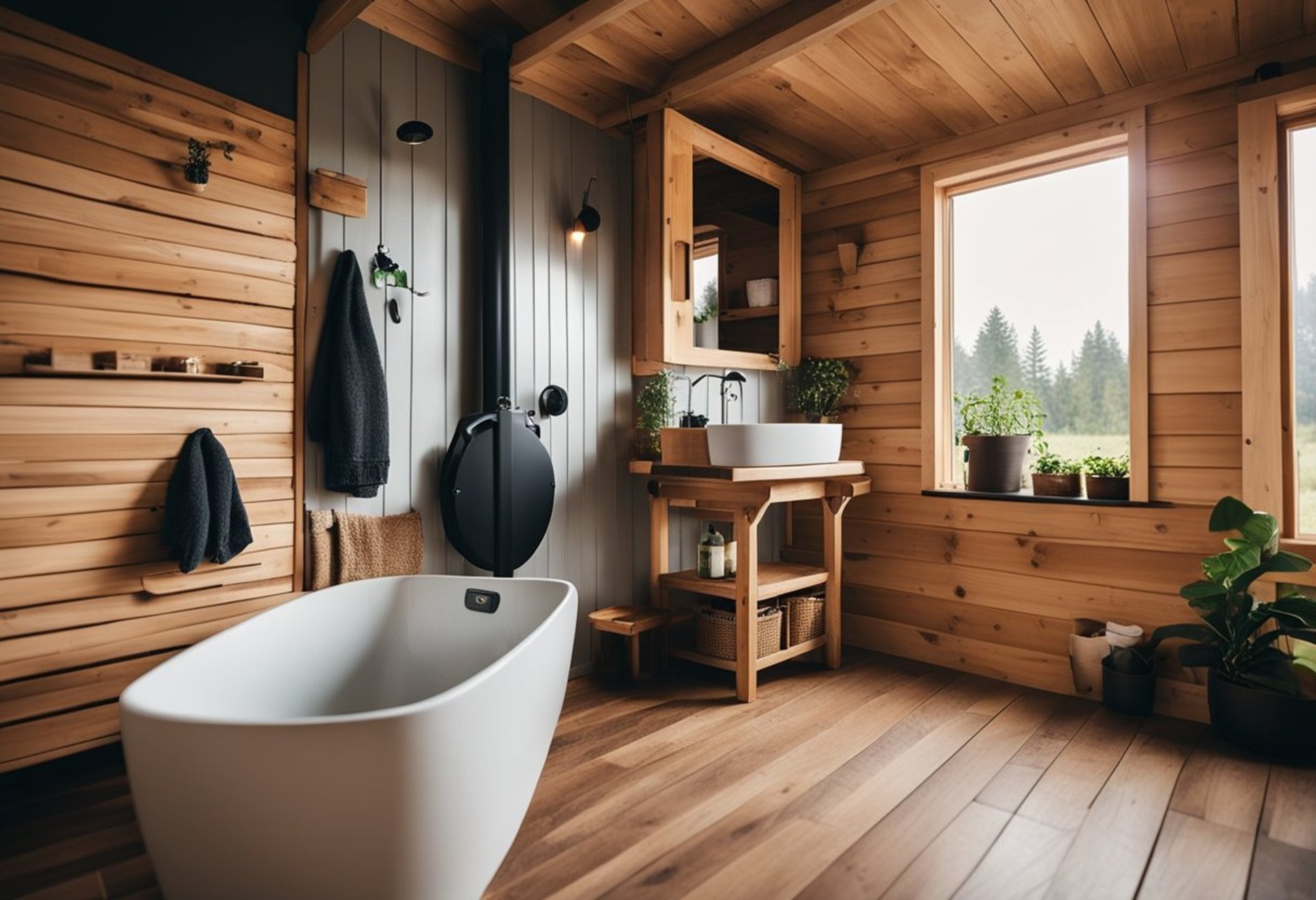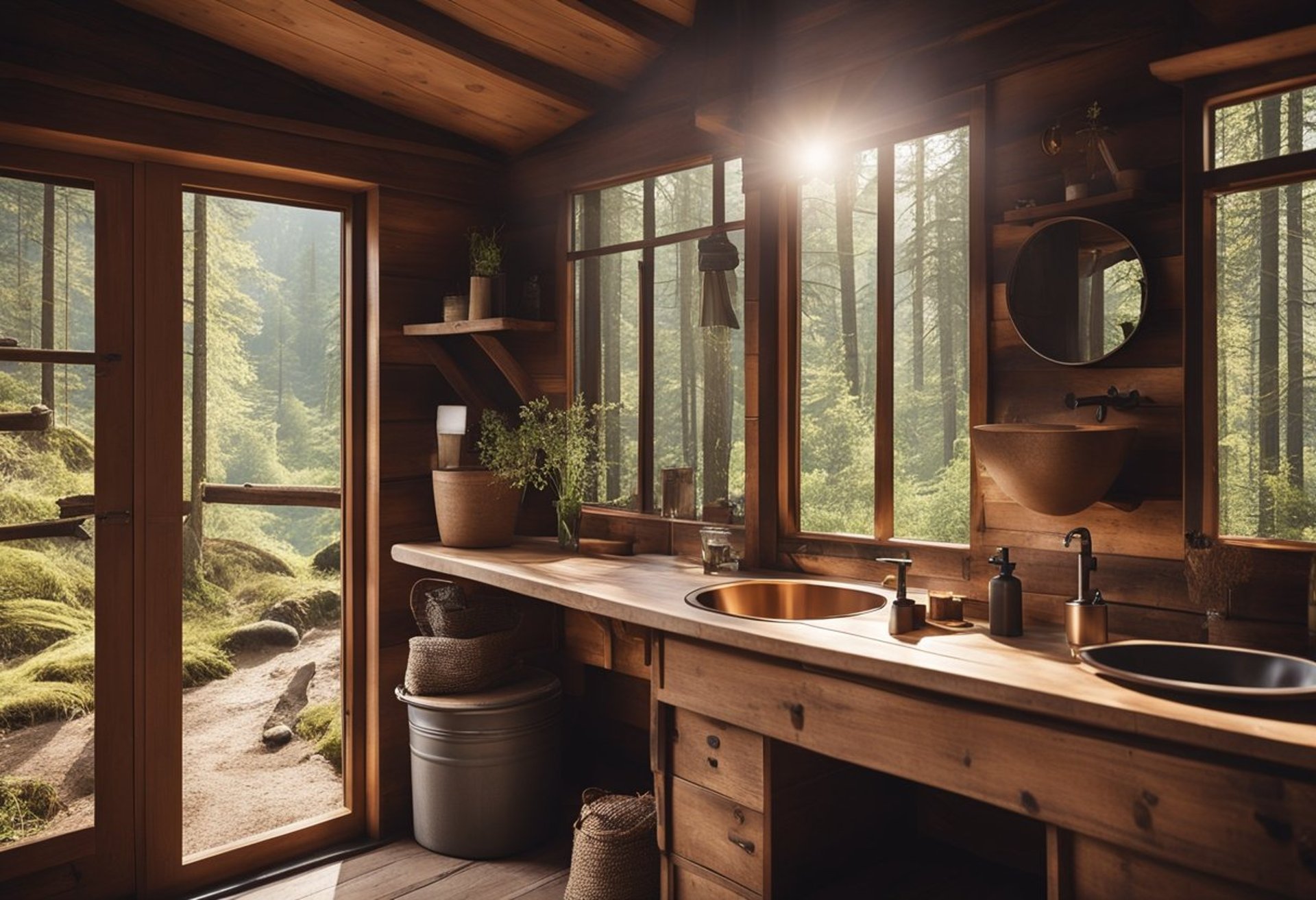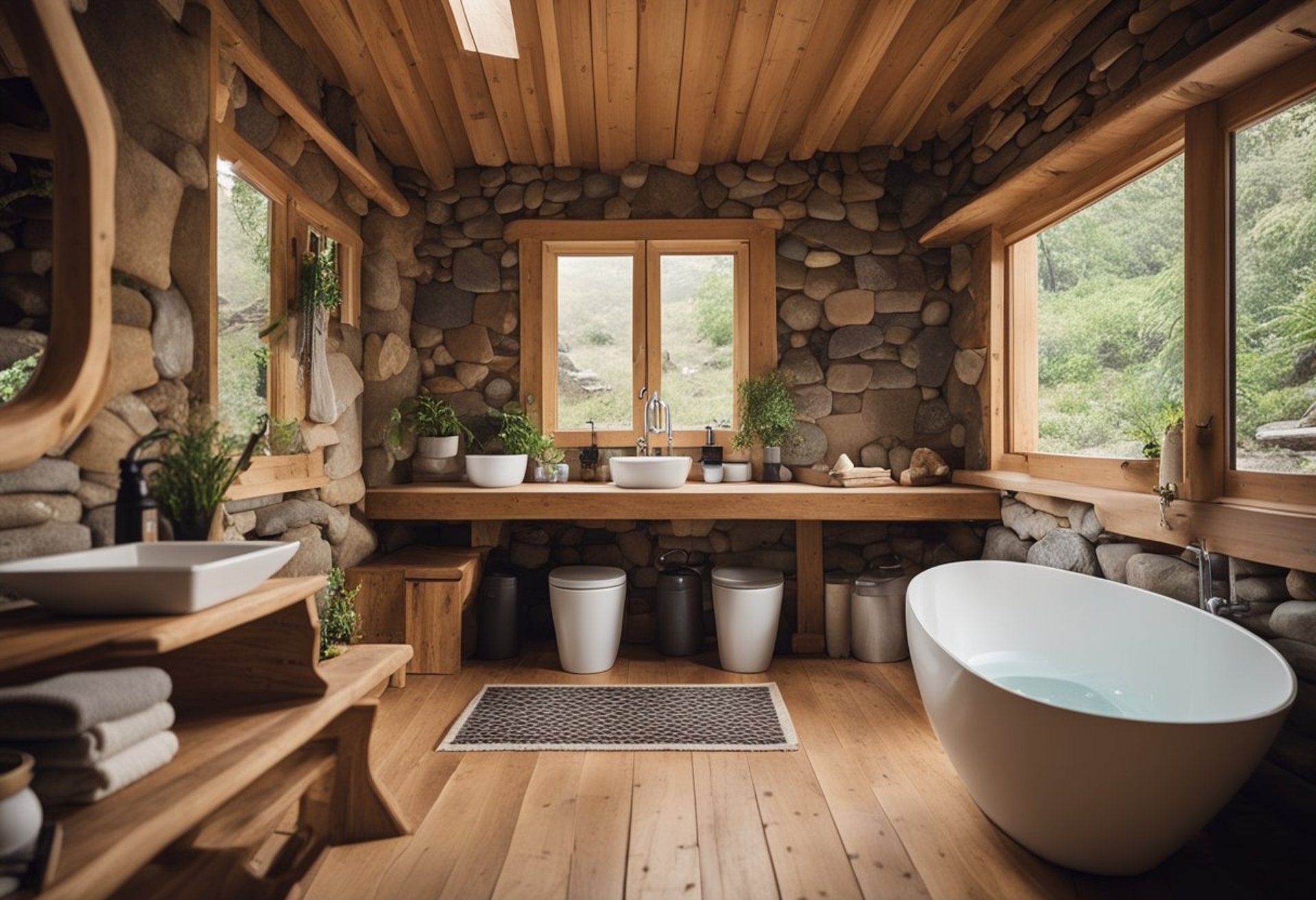Bathroom Design Ideas for Off Grid Cabins: Creating Sustainable and Stylish Spaces
Designing a bathroom for an off-grid cabin requires careful consideration of space and sustainability. Incorporating eco-friendly materials and efficient layouts can create a functional and stylish retreat without compromising on comfort. This blog post explores innovative ideas and practical tips for creating an effective bathroom that harmonizes with nature.
Bathroom Design Ideas for Off Grid Cabins: Creating Sustainable and Stylish Spaces
Designing a bathroom for an off-grid cabin requires careful consideration of space and sustainability. Incorporating eco-friendly materials and efficient layouts can create a functional and stylish retreat without compromising on comfort. This blog post explores innovative ideas and practical tips for creating an effective bathroom that harmonizes with nature.
The integration of solar power, water-saving fixtures, and natural lighting can transform a basic bathroom into a serene sanctuary. Simple design strategies can elevate the space while ensuring it meets off-grid needs. Readers will find inspiration on how to balance aesthetics with functionality in their cabin's bathroom.
Creative solutions and DIY projects can enhance the cabin's overall aesthetic while keeping maintenance manageable. Choices in materials and construction will impact not just beauty but also the sustainability of the bathroom. This article aims to guide the reader through successful bathroom design strategies for an off-grid lifestyle.
Key Takeaways
Sustainable materials enhance cabin aesthetics.
Efficient layouts improve functionality in small spaces.
DIY projects offer creative solutions for off-grid living.
Planning Your Off-Grid Cabin
Planning an off-grid cabin involves thoughtful consideration of various factors, from personal needs to regulatory compliance. A structured approach ensures a comfortable and functional living space.
Assessing Your Needs
Before constructing an off-grid cabin, individuals should evaluate their specific needs. This includes determining the number of occupants, desired amenities, and lifestyle preferences.
While some may prioritize comfort with additional bathroom features like a soaking tub, others might focus on functionality, opting for composting toilets or basic shower setups.
Energy sources also play a crucial role. Users should decide whether they prefer solar, wind, or hydro systems for power. Planners might benefit from listing essentials, such as water access, cooking space, and waste management options.
Considering Space and Layout
The layout of an off-grid cabin significantly impacts daily living. A well-thought-out design maximizes space, improving efficiency and comfort.
Open floor plans often create a spacious feel and allow for better airflow. In contrast, dedicated areas—like separate bathrooms—can enhance privacy.
Incorporating multifunctional furniture can also save space. For instance, a foldable table can serve as both dining and work surfaces.
Natural light should be a consideration too, positioning windows strategically to make the best use of sunlight. Planning for storage is essential, utilizing under-bed or built-in cabinets effectively.
Navigating Legal Requirements
Understanding local building codes and regulations is vital when planning an off-grid cabin. Compliance will affect various aspects, including construction materials and plumbing systems.
Individuals should research zoning laws in their area to ensure their plans align with local regulations. Some regions may have restrictions on building sizes or types, impacting cabin design.
Permits are often required for electrical, plumbing, and other utility installations. Consulting with local authorities can clarify what is needed.
Being aware of septic system requirements or wastewater management systems is also necessary. Each locality may have specific standards for these systems, which can influence the overall design.
Off Grid House Design Fundamentals
Designing an off-grid cabin requires careful consideration of several critical factors. Key elements include maximizing natural light and ventilation, incorporating thermal mass and insulation, and utilizing energy-efficient materials. Effective implementation of these principles can significantly enhance comfort and sustainability.
Maximizing Natural Light and Ventilation
Natural light and ventilation play essential roles in the comfort of an off-grid cabin. Large windows facing south can capture sunlight, reducing the need for artificial lighting during the day. Skylights can also bring in additional light, enhancing the sense of space.
Incorporating operable windows encourages cross-ventilation, allowing fresh air to circulate effectively. This not only regulates indoor temperatures but also improves air quality. Using light-colored walls and reflective surfaces can further amplify natural light within the space.
Positioning windows and openings strategically is crucial. Overhangs can protect from harsh sunlight during summer while allowing winter sun to warm interiors. Such thoughtful design enhances energy efficiency and occupant well-being.
Incorporating Thermal Mass and Insulation
Thermal mass refers to materials that absorb and retain heat. Using materials like concrete or stone can help maintain stable indoor temperatures. This is essential in regions with fluctuating weather conditions.
In addition to thermal mass, effective insulation is vital for minimizing heat loss. Fiberglass or recycled cellulose can be good choices, ensuring that the structure remains warm in winter and cool in summer.
Sealing gaps and using weather stripping can improve insulation performance. Incorporating energy-efficient windows can also reduce heat loss significantly. This combination of thermal mass and insulation maximizes energy efficiency, making the cabin more self-sufficient.
Utilizing Energy Efficient Materials
Selecting the right materials impacts the sustainability of an off-grid cabin. Recycled or locally sourced materials reduce environmental footprint and transportation costs. For instance, reclaimed wood can add character while being eco-friendly.
Low-VOC paints and finishes contribute to healthier indoor air quality, which is especially important in smaller spaces. Additionally, installing energy-efficient appliances can lower energy consumption significantly.
When considering energy sources, materials that facilitate solar panel installation, such as metal roofs, could be beneficial. These roofing types are durable and compatible with various energy solutions. Choosing materials wisely enhances not only the cabin's longevity but also its off-grid capabilities.
Bathroom Design Strategies
Effective bathroom design for off-grid cabins requires integrating sustainability and functionality. Key considerations include water conservation, waste management, and efficient use of space.
Water Conservation Techniques
Water-saving fixtures can dramatically reduce consumption in an off-grid bathroom. Low-flow faucets and showerheads use less water without sacrificing performance. A dual-flush toilet offers flexible options for liquid and solid waste, minimizing flush water use.
Rainwater harvesting systems provide an alternative source. Rainwater can be collected and filtered for bathroom use, allowing for significant cuts in water dependency. Simple plumbing adjustments, such as redirecting outlet pipes to water plants, enhance efficiency.
Additionally, installing timers on showers encourages shorter usage. Informative signage in the bathroom can remind users to conserve, creating a culture of mindful water usage.
Composting Toilet Options
Composting toilets are viable for off-grid living, requiring no water and minimal maintenance. They convert human waste into compost using aerobic bacteria. This process minimizes odor and reduces environmental impact.
Two popular designs include self-contained and split systems. Self-contained toilets hold the waste in one unit, while split systems separate the composting chamber from the toilet.
Both options require regular maintenance, such as periodic removal of compost. Understanding the required maintenance can help make an informed choice. These toilets also reduce the reliance on traditional sewage systems.
Efficient Shower and Bath Solutions
For efficient bathing, consider smaller, enclosed shower spaces that use less water. Installing a recirculating pump can also help by reusing water without needing extensive plumbing.
Portable and collapsible bathtubs are great space-savers. They allow for traditional bathing while conserving water. Users can fill them partially and adjust according to personal preferences.
Additionally, solar shower bags provide a sustainable heating option. Simply fill them with water and leave them in the sun for an eco-friendly bathing solution. This increases independence from electric heating methods, aligning with off-grid living principles.
DIY Solar Power Integration
Integrating solar power into an off-grid cabin can provide a sustainable energy source. Properly selecting and maintaining the components ensures a reliable system for bathroom design and daily needs.
Selecting Solar Panels
Choosing the right solar panels is crucial for efficient energy generation. For off-grid cabins, monocrystalline panels offer high efficiency and a longer lifespan. These panels perform well in limited space, generating more power per square foot.
Factors to consider:
Wattage: Determine wattage needs based on expected energy consumption.
Size: Assess available space for panel installation.
Cost: Balance quality with budget.
Look for panels with a good warranty, usually between 25 to 30 years, as this indicates reliability. It's beneficial to consult with suppliers to select panels best suited for specific energy needs.
Energy Storage Solutions
A robust energy storage system is essential for an off-grid solar setup. Batteries store excess energy generated during sunny periods for use when sunlight is unavailable.
Types of batteries include:
Lead-Acid Batteries: Cost-effective but shorter lifespan.
Lithium-Ion Batteries: Higher efficiency and longevity, albeit at a higher initial cost.
When planning storage capacity, calculate daily energy consumption and select batteries accordingly. A good rule of thumb is to have enough capacity to last through several cloudy days. Ensure the system has a charge controller to prevent overcharging and extend battery life.
Maintaining Your Solar System
Regular maintenance enhances the longevity of a solar power system. Simple tasks keep the system operating at peak performance.
Maintenance tips:
Cleaning Panels: Remove dirt and debris to maximize sunlight absorption.
Monitoring: Use a monitoring system to track energy generation and battery health.
Inspections: Regularly check connections for corrosion and wear.
Schedule maintenance checks at least twice a year. Proper maintenance not only ensures consistent energy supply but also extends the lifespan of solar hardware, reducing long-term costs.
Easy Off-Grid Projects
Selecting simple off-grid projects can enhance self-sufficiency while making life in a cabin more comfortable. Key projects can involve essential survival skills, resource management, and sustainable practices that require minimal investment.
DIY Water Filtration
Creating a DIY water filtration system is essential for ensuring clean drinking water. This project can be accomplished using basic materials like sand, gravel, charcoal, and a suitable container.
Materials Needed:
Clean container (like a bucket)
Sand
Gravel
Activated charcoal
Coffee filter or cloth
Steps:
Lay a coffee filter or cloth at the bottom of the container.
Add a layer of activated charcoal, followed by sand and then gravel.
Slowly pour water through the layers.
This system will help remove impurities and improve the taste of the water, making it suitable for consumption.
Building a Solar Oven
A solar oven can harness sunlight to cook food efficiently and sustainably. This project requires minimal tools and can utilize materials like cardboard and aluminum foil.
Materials Needed:
Cardboard box
Aluminum foil
Plastic wrap
Black paint (optional)
Construction:
Line the interior of the box with aluminum foil to reflect sunlight.
Cut a flap on the top of the box and cover it with plastic wrap for insulation.
Optionally, paint the bottom black to absorb heat.
By positioning the oven towards the sun, it can reach temperatures sufficient for baking and cooking, reducing dependency on traditional fuel sources.
Creating a Vegetable Garden
Establishing a vegetable garden is fundamental for off-grid living. It ensures access to fresh produce while minimizing grocery costs.
Planning:
Identify a sunny area with good soil drainage.
Decide which vegetables to grow based on climate and personal preference.
Preparation:
Clear the area of weeds and debris.
Create raised beds or rows to improve harvest efficiency.
Maintenance:
Regularly water and weed the garden.
Utilize organic methods for pest control, such as companion planting or natural repellents.
With thoughtful planning, a vegetable garden can provide a sustainable food source and contribute to a more self-reliant lifestyle.
Material and Tool Selection
Selecting appropriate materials and tools is essential for creating functional and durable bathrooms in off-grid cabins. The right choices contribute to sustainability and effectiveness in challenging environments.
Durable Materials for Off-Grid Environments
When choosing materials for off-grid cabin bathrooms, focus on durability and resistance to moisture. Options include:
Bamboo: A sustainable alternative, bamboo is strong and water-resistant, making it ideal for cabinetry and flooring.
Recycled Wood: Using reclaimed wood enhances aesthetics while providing resilience against the elements.
Ceramic Tile: Durable and easy to clean, ceramic tiles can withstand high humidity and frequent use.
Natural Stone: Granite or slate offers robustness and natural beauty but may require sealing to prevent water damage.
Consider finishes like water-repellent seals or non-toxic treatments to prolong the lifespan of materials. Always prioritize local sourcing to minimize environmental impact.
Essential Tools for Cabin Projects
The right tools are crucial for effectively constructing a bathroom in an off-grid setting. Essential tools include:
Hand Tools: A solid set of hand tools like saws, hammers, and screwdrivers are indispensable for any construction project.
Power Tools: A battery-operated drill and a circular saw provide more efficiency, especially when electricity is limited.
Level and Measuring Tape: Accuracy is vital, making a level and measuring tape necessary for ensuring straight walls and even fixtures.
Portable Generators: For larger projects, a generator supports power tools and lighting in remote locations.
Having a well-rounded toolkit facilitates smoother and more efficient project completion. Regular maintenance of tools also ensures longevity and performance, especially in off-grid conditions.
Cabin Maintenance and Upkeep
Regular maintenance is essential for keeping an off-grid cabin in good condition. Understanding how to perform inspections and troubleshoot common issues can significantly enhance the longevity and functionality of the cabin's bathroom.
Regular Inspection Routines
Establishing a routine for regular inspections helps identify problems early. Key areas to focus on include:
Plumbing: Check for leaks in pipes and fixtures. Look under sinks, around toilets, and at water supply connections.
Ventilation: Ensure exhaust fans are working efficiently to prevent mold and mildew buildup.
Surfaces: Inspect walls, ceilings, and floors for signs of water damage or wear. Pay attention to grout lines and caulk around fixtures.
Scheduling these inspections quarterly or seasonally minimizes long-term issues. It is advisable to document findings and make necessary repairs immediately. A checklist can simplify this process.
Troubleshooting Common Issues
When problems arise, knowing how to troubleshoot can save time and resources. Common bathroom issues include:
Clogged Drains: Use a plunger or a drain snake for minor clogs. Chemical drain cleaners may be effective but could damage plumbing over time.
Insufficient Hot Water: If hot water is lacking, inspect the water heater for proper settings and any possible sediment buildup.
Foul Odors: Check for plumbing leaks or stagnant water. Cleaning the drains regularly can help maintain a fresh smell.
Addressing problems promptly prevents further complications. Taking the initiative to learn basic repairs can empower cabin owners and enhance their self-sufficiency..






